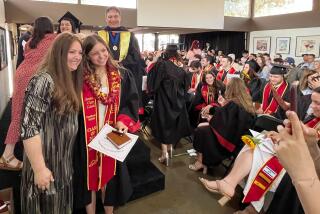Class of ’99 Reaches Out to Captive of ’42
- Share via
It was 1942, and the civics class at Santa Ana High School was discussing the possible internment of Japanese-Americans as a result of the war between the Allied forces and Japan.
To Jim Kanno, a track star and high school junior at the time, the idea was preposterous.
“I think this is crazy,” he remembers saying. “This is a democratic country and that’s what we’re fighting about, to preserve democracy.
“I said there’s no way they’re going to send me away, but 30 days later I was gone,” Kanno recalled.
Kanno and his classmate Hanako Okamoto, who was also evacuated to an internment camp, never graduated from Santa Ana High.
Today they will.
Kanno, now 73, does have a high school diploma. He graduated from a high school set up by other detained Japanese-Americans at a camp in Poston, Ariz., then studied agricultural engineering at UCLA and UC Berkeley after the war.
When real estate speculators were trying to buy his family’s farmland at prices well below what it was worth, Kanno became a leader in the movement to protect their property values by incorporating Fountain Valley. He was elected the city’s first mayor, which made him the first Japanese-American mayor in the continental United States.
And today, 56 years later, the retired real estate developer from North Tustin will be marching in cap and gown as an honored member of the Santa Ana High School class of 1999. His former classmate Okamoto, who owns a vineyard in Napa Valley, is also an honoree but is unable to attend.
“I went all through the Santa Ana schools,” Kanno said Tuesday before leaving for his graduation rehearsal. “I finished Greenville elementary school, Lathrop junior high, and Santa Ana College so I had three of the four. Santa Ana was the missing link.”
He was invited to participate in the ceremony after a unanimous vote by the current student leadership at Santa Ana High School.
“When I first heard that the students actually voted to have me participate with them, it kind of brought tears to my eyes,” Kanno said.
Audrey Yamagata-Noji, a member of the Santa Ana Unified School District’s Board of Education, first learned about Kanno’s link to Santa Ana when he appeared as a panelist at an Asian-American leadership conference she ran.
“How would you feel if we give you your diploma now?” Yamagata-Noji asked Kanno.
“He simply said, ‘I know it’s been done before,’ but he said so with kind of a gleam in his eye and a smile,” she recalled. “Asians in general are taught not to be too direct, and that was his way of saying, ‘Oh, yeah, that will be great.’ ”
Born to a Japanese-American family just after the war, Yamagata-Noji said her parents were also interned. “My parents had been through that as well, and I was so impressed that after all that [Kanno] could come back and be a leader in mainstream American society.”
As word has spread about his upcoming commencement, Kanno has received many phone calls and graduation cards, including some from his former Santa Ana classmates.
Kanno, who has kept up with his class and even attended reunions, says he couldn’t help thinking of what he was missing at Santa Ana High while he was detained in the hot, dirty camp in Arizona.
At Santa Ana, he had been on the track team, and a member of the Sigma social club.
“I did hear from somebody about [the Sigma’s] high jinks. I thought to myself, gee, I sure wish I could have been there, and with the track team. Going to a makeshift high school in the camp, it was not like we had all the activities we ordinarily had.”
Kanno will sit on stage with the class officers during the graduation, and he will be introduced by Yamagata-Noji.
He said his wife and children are excited about the event, while his 10-year-old grandson jokes that it’s embarrassing that grandpa is 73 and is only now finishing high school.
As for Kanno’s new fellow graduates at Santa Ana High, Yamagata-Noji said she hopes they will come away from the ceremony with a powerful role model in Kanno.
“These are students who have been through the anti-immigration, anti-affirmative action, and anti-foreign language movements,” she said. “It’s a lesson in citizenship. In a very ironic way, it has particular impact on Santa Ana High, because that school probably has the highest percentage of immigrant students than possibly any other high school in the state.”
More to Read
Sign up for Essential California
The most important California stories and recommendations in your inbox every morning.
You may occasionally receive promotional content from the Los Angeles Times.













